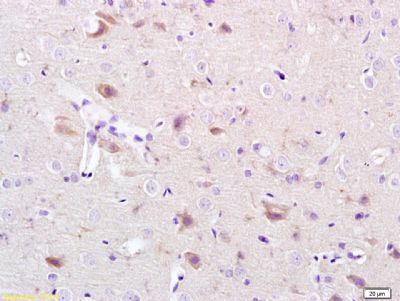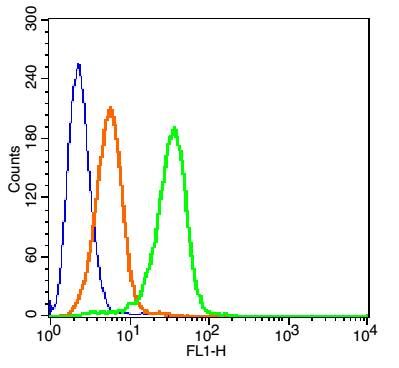产品中心
当前位置:首页>产品中心Anti-CACNA1G
货号: bs-2781R 基本售价: 1380.0 元 规格: 100ul
- 规格:100ul
- 价格:1380.00元
- 规格:200ul
- 价格:2200.00元
产品信息
- 产品编号
- bs-2781R
- 英文名称
- CACNA1G
- 中文名称
- 电压依赖性钙通道Cav3.1抗体
- 别 名
- calcium channel voltage dependent alpha 1G subunit; calcium channel voltage dependent T type alpha 1G subunit; calcium channel voltage dependent T type alpha1G subunit; CaV T1; Cav3 1; cav3 1c; NBR13; voltage dependent calcium channel alpha 1G subunit isoform 11; voltage dependent T type calcium channel subunit alpha 1G; CAC1G_HUMAN; Cav3.1

- Specific References (1) | bs-2781R has been referenced in 1 publications.[IF=2.36] Lu, Yujie, et al. "Mibefradil reduces blood glucose concentration in db/db mice." Clinics 69.1 (2014): 61. WB ; Mouse.PubMed:24473561
- 规格价格
- 100ul/1380元购买 200ul/2200元购买 大包装/询价
- 说 明 书
- 100ul 200ul
- 研究领域
- 通道蛋白
- 抗体来源
- Rabbit
- 克隆类型
- Polyclonal
- 交叉反应
- Human, Mouse, Rat, Dog, Pig, Cow, Guinea Pig,
- 产品应用
- ELISA=1:1000-10000 IHC-P=1:400-800 IHC-F=1:400-800 Flow-Cyt=1μg /Test IF=1:100-500 (石蜡切片需做抗原修复)
not yet tested in other applications.
optimal dilutions/concentrations should be determined by the end user.
- 分 子 量
- 262kDa
- 细胞定位
- 细胞膜
- 性 状
- Lyophilized or Liquid
- 浓 度
- 1mg/ml
- 免 疫 原
- KLH conjugated synthetic peptide derived from human CACNA1G/Cav31:901-1000/2377 <Extracellular>
- 亚 型
- IgG
- 纯化方法
- affinity purified by Protein A
- 储 存 液
- 0.01M TBS(pH7.4) with 1% BSA, 0.03% Proclin300 and 50% Glycerol.
- 保存条件
- Store at -20 °C for one year. Avoid repeated freeze/thaw cycles. The lyophilized antibody is stable at room temperature for at least one month and for greater than a year when kept at -20°C. When reconstituted in sterile pH 7.4 0.01M PBS or diluent of antibody the antibody is stable for at least two weeks at 2-4 °C.
- PubMed
- PubMed
- 产品介绍
- background:
Voltage-sensitive calcium channels mediate the entry of calcium ions into excitable cells, and are also involved in a variety of calcium-dependent processes, including muscle contraction, hormone or neurotransmitter release, gene expression, cell motility, cell division, and cell death. This gene encodes a T-type, low-voltage activated calcium channel. The T-type channels generate currents that are both transient, owing to fast inactivation, and tiny, owing to small conductance. T-type channels are thought to be involved in pacemaker activity, low-threshold calcium spikes, neuronal oscillations and resonance, and rebound burst firing. Many alternatively spliced transcript variants encoding different isoforms have been described for this gene. [provided by RefSeq, Sep 2011]
Function:
Voltage-sensitive calcium channels (VSCC) mediate the entry of calcium ions into excitable cells and are also involved in a variety of calcium-dependent processes, including muscle contraction, hormone or neurotransmitter release, gene expression, cell motility, cell division and cell death. The isoform alpha-1G gives rise to T-type calcium currents. T-type calcium channels belong to the low-voltage activated (LVA) group and are strongly blocked by mibefradil. A particularity of this type of channels is an opening at quite negative potentials and a voltage-dependent inactivation. T-type channels serve pacemaking functions in both central neurons and cardiac nodal cells and support calcium signaling in secretory cells and vascular smooth muscle. They may also be involved in the modulation of firing patterns of neurons which is important for information processing as well as in cell growth processes.
Subcellular Location:
Membrane; Multi-pass membrane protein.
Tissue Specificity:
Highly expressed in brain, in particular in the amygdala, subthalamic nuclei, cerebellum and thalamus. Moderate expression in heart; low expression in placenta, kidney and lung. Also expressed in colon and bone marrow and in tumoral cells to a lesser extent. Highly expressed in fetal brain, but also in peripheral fetal tissues as heart, kidney and lung, suggesting a developmentally regulated expression.
Similarity:
Belongs to the calcium channel alpha-1 subunit (TC 1.A.1.11) family. CACNA1G subfamily.
SWISS:
O43497
Gene ID:
8913
Database links:Entrez Gene: 8913Human
Entrez Gene: 12291Mouse
Entrez Gene: 29717Rat
Omim: 604065Human
SwissProt: O43497Human
SwissProt: O54898Rat
Unigene: 29585Mouse
Unigene: 86960Rat
Important Note:
This product as supplied is intended for research use only, not for use in human, therapeutic or diagnostic applications.
- 产品图片
 Tissue/cell: rat brain tissue; 4% Paraformaldehyde-fixed and paraffin-embedded;
Tissue/cell: rat brain tissue; 4% Paraformaldehyde-fixed and paraffin-embedded;
Antigen retrieval: citrate buffer ( 0.01M, pH 6.0 ), Boiling bathing for 15min; Block endogenous peroxidase by 3% Hydrogen peroxide for 30min; Blocking buffer (normal goat serum,C-0005) at 37℃ for 20 min;
Incubation: Anti-CACNA1G/Cav3.1 Polyclonal Antibody, Unconjugated(bs-2781R) 1:200, overnight at 4°C, followed by conjugation to the secondary antibody(SP-0023) and DAB(C-0010) staining Blank control(blue): MCF7 Cells(fixed with 2% paraformaldehyde (10 min). The cells were washed twice with 1 X PBS).
Blank control(blue): MCF7 Cells(fixed with 2% paraformaldehyde (10 min). The cells were washed twice with 1 X PBS).
Primary Antibody: Rabbit Anti- CACNA1G/AF488 Conjugated antibody (bs-2781R-AF488), Dilution: 1μg in 100 μL 1X PBS containing 0.5% BSA;
Isotype Control Antibody: Rabbit IgG/AF488(orange) ,used under the same conditions.

